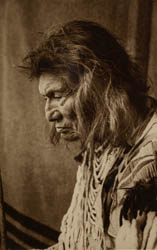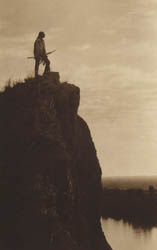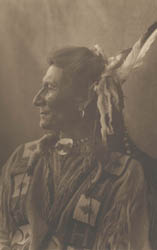Photographing the American Indian:
Portraits of Native Americans, 1860-1913, from the collections of
the Massachusetts Historical Society
Photographs from the Wanamaker Expeditions, 1908-1913
The seven photogravure prints of Native Americans and the lecture program featured here date from the Wanamaker Indian expeditions of 1908, 1909, and 1913.These expeditions were organized and funded by Rodman Wanamaker, heir to the Philadelphia-based Wanamaker department store fortune, and a political advocate for the rights of Native Americans to citizenship in the United States. Wanamaker was particularly concerned that the life and culture of the "vanishing race" would be lost to modernity and relegated to reservation life.To further his cause and to publicize the plight of the American Indian, Wanamaker funded these expeditions to document Indian life and culture through photography, film, and sound recordings.
On each of these expeditions, Rodman Wanamaker employed former Baptist preacher and lecturer Joseph Kossuth Dixon as his official photographer and expedition leader. Dixon had previously been employed by Rodman’s father, John Wanamaker, as a lecturer for, and the director of, the Wanamaker department store's education bureau. In his new position with the expeditions, Joseph K. Dixon took over 8,000 negatives of Native Americans, including the photogravures exhibited here. Unlike Adam Clark Vroman's work, Dixon's photographs over the course of these three trips have been criticized for their sentimentality. Through staged shots and photographic manipulation, Dixon emphasized the romanticism of the "noble savage"—a message that clearly complemented Wanamaker's desire to stir sympathy for Native Americans in the hearts of white citizens.
About the Photographer and the Expeditions
All of the photogravures depicted here are separate prints held by the Massachusetts Historical Society in the Wanamaker expeditions photograph collection. These prints also appear in Joseph K. Dixon's illustrated record of the Wanamaker expeditions, The Vanishing Race: The Last Great Indian Council, which was published in 1913, the year of the final journey. The dates assigned to each photograph in this exhibit thus reflect the date of Dixon's publication; however, the original photographs may have been taken during any of Dixon's three trips in 1908, 1909, or 1913.
Each of the Wanamaker expeditions was organized around a particular conceit that Rodman Wanamaker had chosen as a means to "accurately" depict and preserve Indian life. During the first expedition in 1908, Joseph K. Dixon traveled to the Crow reservation in Montana to film a version of Henry Longfellow's poem, "Song of Hiawatha," using the Native Americans at the agency as actors. He also photographed the Crows at their camp at Little Big Horn. The following year, Rodman Wanamaker charged Dixon with organizing an "old-time Indian council" at the Crow Agency, a traditional gathering of fifty chiefs from several United States reservations to discuss tribal politics; the last gathering of its kind had reportedly occurred in 1867. As with the 1908 expedition, this "Last Great Indian Council," as Dixon and Wanamaker called it, was recorded on motion-picture film and in photographs. During the last expedition in 1913, Dixon organized and photographed a series of flag-raising ceremonies on dozens of Indian reservations across the West, purportedly to show Indian allegiance to the United States and to publicize Rodman Wanamaker's efforts at lobbying for the citizenship of Native Americans.
********** DO NOT EDIT THIS LINE OR BELOW*************










